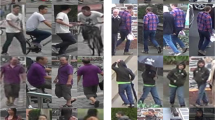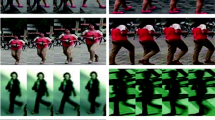Abstract
Person re-identification (ReID) aims to associate the person with the given identity across different cameras, which has wide application in the field of intelligent video. In this work, an efficient method is proposed to improve ReID performance. First, a global-guided feature joint network is designed, which consists of a multiple feature extraction network and a global-guided feature fusion network. The former can align different body regions and extract global feature and local features. The latter utilizes the global feature to guide the adaptive fusion of the local features, which can evaluate the importance of different local features dynamically. Secondly, a Bi-relevance TriHard loss (TriBR) is designed to penalize the loss dynamically. TriBR combines Euclidean distance and angle information, which considers the self-relevance of the intra-class samples and the cross-relevance of the inter-class samples simultaneously. Besides, TriBR can adaptively adjust the distance margin and the angle margin to optimize the network. The proposed TriBR is advantageous to learn more discriminative features. The method achieves 89.2% mAP (mean Average Precision) with 95.8% Rank-1 on Market-1501, 79.7% mAP with 89.3% Rank-1 on DukeMTMC. The proposed method also performs excellently on the datasets for the occluded person re-identification problem.













Similar content being viewed by others
References
Farenzena M, Bazzani L, Perina A, Murino V, Cristani M (2010) Person re-identification by symmetry-driven accumulation of local features. In Proceedings of IEEE CVPR, pp 2360–2367, California
Zhao R, Ouyang W, Wang X (2013) Person re-identification by salience matching. In Proceedings of IEEE ICCV, pp 2528–2535, Hobart
Wang X, Ming Y, Zhu S, Lin Y (2013) Regionlets for generic object detection. In Proceedings of IEEE ICCV, pp 17–24, Hobart
Liu X, Song M, Tao D, Zhou X, Bu J (2014) Semi-supervised coupled dictionary learning for person re-identification. In Proceedings of IEEE CVPR, pp 3550–3557, Columbus
Li W, Zhao R, Xiao T, Wang X (2014) Deepreid: Deep filter pairing neural network for person re-identification. In Proceedings of IEEE CVPR, pp 152–159, Columbus
Xiao T, Li H, Ouyang W, Wang X (2016) Learning deep feature representations with domain guided dropout for person re-identification. In Proceedings of IEEE CVPR, pp 1249–1258, Las Vegas
Liu J, Ni B, Yan Y, Zhou P, Cheng S, Hu J (2018) Pose transferrable person re-identification. In Proceedings of IEEE CVPR, pp 4099–4108, Salt Lake City
Huang Z, Qin W, Luo F, Guan T, Xie F, Han S, Sun D (2021) Combination of validity aggregation and multi-scale feature for person re-identification. J Ambient Intell Human Comput, Early Access
Varior R, Haloi M, Wang G (2016) Gated siamese convolutional neural network architecture for human re-identification. In Proceedings of IEEE ECCV, pp 791–808, Amsterdam
Schroff F, Kalenichenko D, Philbin J (2015) Facenet: A unified embedding for face recognition and clustering. In Proceedings of IEEE CVPR, pp 845–853, Boston
Hermans A, Beyer L, Leibe B (2017) In defense of the triplet loss for person re-identification
Chen W, Chen X, Zhang J, Huang K (2017) Beyond triplet loss: a deep quadruplet network for person re-identification. In Proceedings of IEEE CVPR, pp 1320–1329, Honolulu
Varior R, Gang W, Lu J (2014) Learning invariant color features for person re-identification. IEEE Trans Image Process 25(7):3395–3410
Ding G, Khan S, Tang Z, Porikli F (2017) Let features decide for themselves: Feature mask network for person re-identification
Zheng Z, Zheng L, Yang Y (2019) Pedestrian alignment network for large-scale person re-identification. IEEE Trans Circuits Syst Video Technol 29(10):3037–3045
Zhao H, Tian M, Sun S, Jing S, Tang X (2017) Spindle net: Person re-identification with human body region guided feature decomposition and fusion. In Proceedings of IEEE CVPR, pp 907–915, Honolulu
Zheng L, Huang Y, Lu H, Yang Y (2019) Pose invariant embedding for deep person re-identification. IEEE Trans Image Process 28(9):4500–4509
Li D, Wei X, Hong X, Gong Y (2020) Infrared-visible cross-modal person re-identification with an x modality. In Proceedings of AAAI, pp 4610–4617, New York
Li W, Zhu X, Gong S (2018) Harmonious attention network for person re-identification. In Proceedings of IEEE CVPR, Salt Lake City
Xiao Q, Luo H, Zhang C (2017) Margin sample mining loss: A deep learning based method for person re-identification. In Proceedings of IEEE CVPR, pp 3346–3355, Honolulu
Ma W, Han H, Zhang Y, Wang C (2018) Metric learning algorithm based on weighted pairwise constrained component analysis for person re-identification. In Proceedings of IEEE ICCT, pp 1154–1158, Chongqing
Liu H, Ma B, Qin L, Pang J, Zhang C, Huang Q (2015) Set-label modeling and deep metric learning on person re-identification. Neurocomputing 151:1283–1292
Chen D, Yuan Z, Chen B, Zheng N (2016) Similarity learning with spatial constraints for person re-identification. In Proceedings of IEEE CVPR, pp 1268–1277, Las Vegas
Wang J, Zhou F, Wen S, Liu X, Lin Y (2017) Deep metric learning with angular loss. In Proceedings of IEEE ICCV, pp 2610–2620, Venice
Wang Y, Wang Z, Jiang M, Chen L, Shen T, Zhang W (2020) Joint deep learning of angular loss and hard sample mining for person re-identification
Wei S, Ramakrishna V, Kanade T, Sheikh Y (2016) Convolutional pose machines. In Proceedings of IEEE CVPR, pp 4724–4732, Las Vegas
Zheng L, Shen L, Tian L, Wang S, Wang J, Tian Q (2015) Scalable person re-identification: A benchmark. In Proceedings of IEEE ICCV, pp 1116–1124, Santiago
Ristani E, Solera F, Zou R, Cucchiara R, Tomasi C (2016) Performance measures and a data set for multi-target, multicamera tracking. In Proceedings of IEEE ICCV, pp 17–35, Amsterdam
Miao J, Wu Y, Liu P, Ding Y, Yang Y (2019) Pose-guided feature alignment for occluded person re-identification. In Proceedings of IEEE ICCV, pp 542–551, Seoul
Zheng W, Gong S, Xiang T (2011) Person re-identification by probabilistic relative distance comparison. In Proceedings of IEEE CVPR, pp 649–656, Providence
Deng J, Dong W, Socher R, Li L, Li K, Li F (2009) Imagenet: A large-scale hierarchical image database. In Proceedings of IEEE CVPR, pp 248–255, Florida
Zhong Z, Zheng L, Kang G, Li S, Yang Y (2017) Random erasing data augmentation
Fang P, Zhou J, Roy S, Petersson L, Harandi M (2019) Bilinear attention networks for person retrieval. In Proceeding of IEEE ICCV, pp 8029–8038, Seoul
Shen Y, Xiao T, Li H, Yi S, Wang X (2018) End-to-end deep kronecker-product matching for person re-identification. In Proceedings of IEEE CVPR, pp 6886–6895, Salt Lake City
Zheng X, Luo H, Fan X, Xiang W, Jian S (2017) Alignedreid: Surpassing human-level performance in person re-identification
Sun Y, Zheng L, Yang Y, Wang S, Tian Q (2018) Beyond part models: Person retrieval with refined part pooling (and a strong convolutional baseline). In Proceedings of IEEE ECCV, pp 501–518, Munich
Dai Z, Chen M, Gu X, Zhu S, Tan P (2019) Batch dropblock network for person re-identification and beyond. In Proceedings of IEEE ICCV, pp 3690–3700, Seoul
Hou R, Ma B, Chang H, Gu X, Shan S, Chen X (2019) Interaction-and-aggregation network for person re-identification. In Proceedings of IEEE CVPR, pp 9309–9318, California
Zhuang Z, Wei L, Xie L, Zhang T, Zhang H, Wu H, Ai H, Tian Q (2020) Rethinking the distribution gap of person re-identification with camera-based batch normalization
Zheng Z, Yang X, Yu Z, Zheng L, Yang Y, Kautz J (2019) Joint discriminative and generative learning for person re-identification. In Proceedings of IEEE CVPR, pp 2133–2142, California
Yang W, Huang H, Zhang Z, Chen X, Zhang S (2019) Towards rich feature discovery with class activation maps augmentation for person re-identification. In Proceedings of IEEE CVPR, pp 1389–1398, California, (2019)
Wang G, Yang S, Liu H, Wang Z, Yang Y, Wang S, Yu G, Zhou E, Sun J (2020) High-order information matters: Learning relation and topology for occluded person re-identification. In Proceedings of IEEE CVPR, pp 6448–6457, Washington
Dai Z, Chen M, Zhu S, Tian P (2018) Batch feature erasing for person re-identification and beyond
Li W, Zhu X, Gong S (2018) Deep spatial feature reconstruction for partial person re-identification: Alignment-free approach. In Proceedings of IEEE CVPR, pp 2285–2294, Salt Lake City
He L, Liang J, Li H, Sun Z (2018) Deep spatial feature reconstruction for partial person re-identification: Alignment-free approach. In Proceedings of IEEE CVPR, pp 7073–7082, Salt Lake City
Miao J, Wu Y, Liu P, Ding Y, Yang Y (2019) Pose-guided feature alignment for occluded person re-identification. In Proceedings of IEEE ICCV, pp 542–551, Seoul
Miao J, Wu Y, Yang Y (2021) Identifying visible parts via pose estimation for occluded person re-identification. IEEE Trans Neural Netw Learn Syst, p 99
Zheng W, Li X, Xiang T, Liao S, Lai J, Gong S (2015) Partial person re-identification
Sun Y, Xu Q, Li Y, Zhang C, Li Y, Wang S, Sun J (2019) Perceive where to focus: Learning visibility-aware part-level features for partial person reidentification. In Proceedings of IEEE CVPR, pp 393–402, California
Author information
Authors and Affiliations
Corresponding author
Ethics declarations
Conflicts of interest
The authors declare no conflict of interest exists.
Additional information
Publisher's Note
Springer Nature remains neutral with regard to jurisdictional claims in published maps and institutional affiliations.
Rights and permissions
About this article
Cite this article
Yu, Z., Qin, W., Huang, Z. et al. Joining features by global guidance with bi-relevance trihard loss for person re-identification. Neural Comput & Applic 34, 8697–8712 (2022). https://doi.org/10.1007/s00521-021-06852-4
Received:
Accepted:
Published:
Issue Date:
DOI: https://doi.org/10.1007/s00521-021-06852-4




